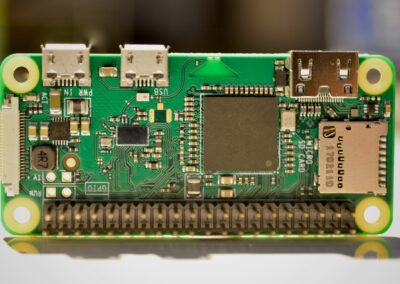Reducing the Attack Surface in Modern Cybersecurity Strategies
The Evolution of Network Security: Embracing Zero Trust
Micro-segmentation is a crucial component of zero trust architecture, providing a method to enhance network security by dividing the network into smaller, manageable segments. This approach limits the lateral movement of attackers within the network, effectively reducing the attack surface. For business executives, mid-level managers, and entrepreneurs in Saudi Arabia, the UAE, Riyadh, and Dubai, understanding and implementing micro-segmentation can significantly bolster their cybersecurity posture.
In these regions, where digital transformation is rapidly advancing, the adoption of cutting-edge cybersecurity measures is essential to safeguard against sophisticated cyber threats. By integrating micro-segmentation within a zero trust framework, organizations can ensure robust protection of their digital assets, thereby supporting business success and resilience in an increasingly connected world.
Implementing Micro-Segmentation: Strategies and Best Practices
Micro-segmentation involves the creation of isolated network segments, each with its own security controls and policies. This granular approach to network security ensures that even if an attacker breaches one segment, they cannot easily move to other parts of the network. To implement micro-segmentation effectively, organizations must follow strategic steps and best practices.
Firstly, it is essential to conduct a comprehensive assessment of the network infrastructure to identify critical assets, data flows, and potential vulnerabilities. This assessment forms the basis for designing a segmentation strategy that aligns with the organization’s security objectives. In regions like Riyadh and Dubai, where regulatory compliance and data protection are paramount, such assessments are crucial to ensure that micro-segmentation efforts meet local and international standards.
Next, organizations should leverage advanced technologies such as software-defined networking (SDN) and network virtualization to facilitate the implementation of micro-segmentation. These technologies enable dynamic and flexible segmentation, allowing security policies to be applied consistently across all network segments. Additionally, continuous monitoring and real-time analytics are vital to detect and respond to any anomalies or unauthorized activities within the segmented network.
Furthermore, collaboration and training are key components of a successful micro-segmentation strategy. Business leaders, IT teams, and security professionals must work together to develop and enforce security policies that govern each segment. Regular training sessions and awareness programs ensure that all employees understand the importance of micro-segmentation and adhere to the established security protocols.
Business Benefits of Micro-Segmentation in Zero Trust Architecture
Adopting micro-segmentation within a zero trust architecture offers several significant benefits for businesses, particularly in high-risk and digitally advanced environments like Saudi Arabia and the UAE. One of the primary advantages is the enhanced security posture it provides by minimizing the attack surface. By isolating network segments, organizations can prevent the spread of malware and limit the impact of potential breaches.
Another critical benefit is the ability to achieve greater visibility and control over network traffic. Micro-segmentation allows organizations to monitor and manage data flows at a granular level, enabling more effective threat detection and response. This level of visibility is particularly valuable in industries such as finance, healthcare, and government, where the protection of sensitive information is of utmost importance.
Moreover, micro-segmentation supports regulatory compliance by ensuring that data is appropriately segmented and secured according to legal and industry-specific requirements. For businesses operating in regions with stringent data protection laws, such as the UAE and Saudi Arabia, this compliance is essential to avoid legal repercussions and maintain customer trust.
In addition to security and compliance benefits, micro-segmentation also contributes to operational efficiency. By segmenting the network, organizations can implement tailored security policies for different segments, optimizing resource allocation and reducing the complexity of managing a monolithic security framework. This streamlined approach not only enhances security but also reduces the administrative burden on IT and security teams.
Challenges and Considerations in Deploying Micro-Segmentation
Overcoming Technical and Operational Challenges
While the benefits of micro-segmentation are clear, deploying this strategy within a zero trust architecture presents several challenges. One of the primary technical challenges is the complexity of network architecture. Implementing micro-segmentation requires a deep understanding of the network’s structure, data flows, and potential points of vulnerability. This complexity can be daunting, particularly for large organizations with extensive and intricate networks.
To overcome this challenge, organizations should invest in advanced network visualization and mapping tools that provide a comprehensive view of the network infrastructure. These tools can help identify critical assets, map data flows, and highlight areas that require segmentation. Additionally, leveraging artificial intelligence (AI) and machine learning (ML) technologies can enhance the accuracy and efficiency of network analysis and segmentation efforts.
Operational challenges also arise from the need for continuous monitoring and management of segmented networks. Maintaining the integrity and security of each segment requires ongoing vigilance, real-time analytics, and prompt response to any detected threats. Organizations must establish robust monitoring and incident response processes to ensure that security policies are consistently enforced and any anomalies are swiftly addressed.
Ensuring Compatibility with Existing Systems
Another significant consideration is the compatibility of micro-segmentation with existing systems and applications. Integrating micro-segmentation within a zero trust architecture involves ensuring that all network components, including legacy systems, are compatible with the new security framework. This can be particularly challenging in environments where older systems are still in use and may not support advanced segmentation techniques.
To address this issue, organizations should adopt a phased approach to implementation, gradually integrating micro-segmentation into the network while ensuring compatibility with existing systems. This approach allows for the identification and resolution of any compatibility issues before full deployment. Additionally, working closely with technology vendors and leveraging their expertise can facilitate the seamless integration of micro-segmentation into the network infrastructure.
Conclusion: A Strategic Imperative for Cybersecurity
In conclusion, the integration of micro-segmentation within a zero trust architecture represents a strategic imperative for organizations seeking to enhance their cybersecurity posture. For business executives, mid-level managers, and entrepreneurs in regions like Saudi Arabia, the UAE, Riyadh, and Dubai, understanding and implementing micro-segmentation is crucial to protecting digital assets and ensuring business success.
By addressing the technical and operational challenges, leveraging advanced technologies, and fostering collaboration across the organization, businesses can effectively deploy micro-segmentation and reap its numerous benefits. This approach not only reduces the attack surface and enhances threat detection but also supports regulatory compliance and operational efficiency.
As cyber threats continue to evolve, adopting a zero trust architecture with micro-segmentation at its core will empower organizations to stay ahead of attackers and secure their digital future. Embracing this advanced cybersecurity strategy is essential for achieving resilience and success in an increasingly connected and digitized world.
#MicroSegmentation #ZeroTrust #CyberSecurity #NetworkSecurity #SaudiArabia #UAE #Riyadh #Dubai #BusinessSuccess #LeadershipSkills #ProjectManagement























